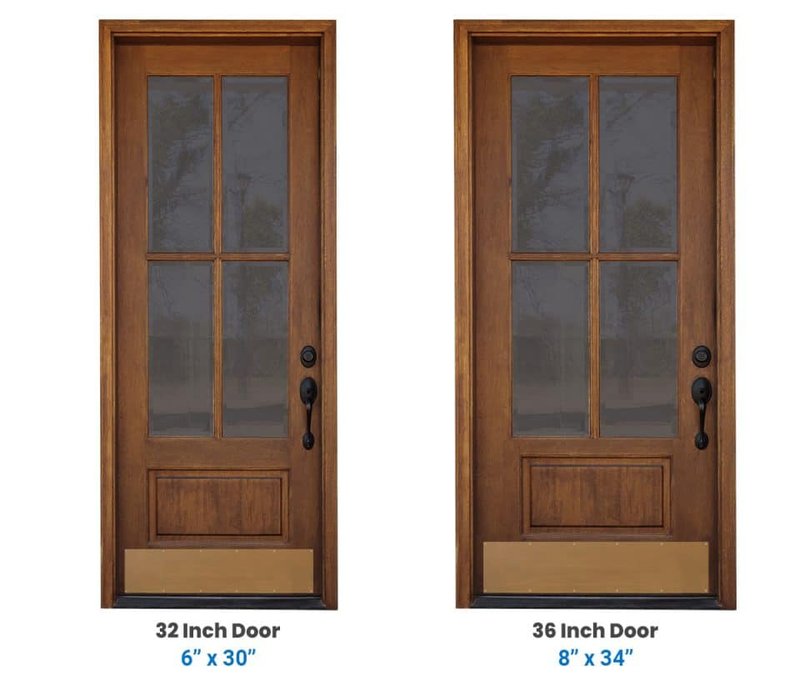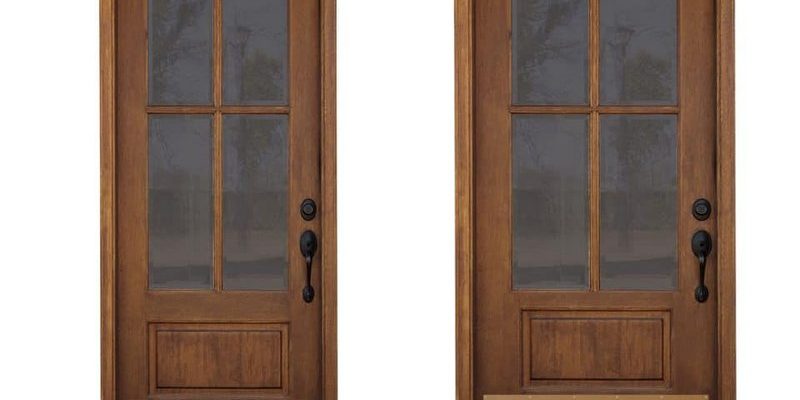
Here’s the thing: picking the wrong kick plate can look awkward or leave parts of your door unprotected. You probably want something that fits just right, like a well-tailored suit, rather than a one-size-fits-all poncho. Whether you’ve got a classic wooden door, a modern metal one, or you’re dealing with a specialty brand, the steps for sizing a kick plate are pretty much the same. Let me walk you through how to do it—no tools required (just yet).
Why Kick Plate Size Actually Matters
You might be wondering, “Does a quarter-inch here or there even make a difference?” Honestly, yes—it does. The size of your kick plate affects not only how much protection your door gets but also how the finished look ties into your home’s style. A kick plate that’s too short leaves corners vulnerable to damage, while one that’s too wide can bump into the door frame or even mess with the door’s function.
Think about it this way: the kick plate acts as armor for the most abused part of your door. Every time you jam it open with your foot or slide furniture through, the plate stops scuffs and scratches from ruining the paint or wood underneath. If you pick the wrong size, you might find yourself troubleshooting why the door suddenly won’t close right—or why it looks off-balance.
And let’s be honest, nobody wants to redo a DIY project because the first try ended up lopsided. Getting the right size the first time just saves time and makes your door look sharp. Whatever brand or code the hardware uses, sizing is step one in the process.
How To Measure Your Door For A Kick Plate
Let me explain how you can easily measure your door before choosing a kick plate. Grab a tape measure and measure the *width* of your door from edge to edge along the bottom. This number is your starting point. Most standard doors are 32, 34, or 36 inches wide, but don’t just assume—older homes or specialty doors can throw you a curveball.
Now, here’s a little trick: you don’t want a kick plate that covers the entire width of the door. Instead, you want it a bit shorter—typically leaving about 1 to 2 inches of space on each side. This keeps the plate from overlapping onto the door jamb or weatherstripping, which can mess with how your door closes. For example, if your door is 36 inches wide, a 34-inch kick plate gives you that perfect fit.
As for height, standard kick plates are usually 6 to 8 inches tall. Think about where the kicks and scuffs usually land—if you’ve got kids (or energetic pets), you might want to go a bit taller. But in most cases, 6 inches does the job without dominating the look of your door.
Standard Kick Plate Sizes (And When To Go Custom)
Most kick plates come in a handful of common sizes, which fit the vast majority of entry, utility, and garage doors. Here’s a quick breakdown:
- 30-inch: Fits narrow doors found in some apartments or interior spaces.
- 32-inch: Common for older homes or utility doors.
- 34-inch: A usual match for mid-sized exterior doors.
- 36-inch: The standard go-to for most front doors in the U.S.
Heights usually range from 6 to 8 inches, as mentioned earlier. If your door doesn’t fit these sizes, don’t panic—you can order custom kick plates with exact measurements. These are easy to code into most hardware store systems or order online using the door’s exact width and your chosen height.
Pro tip: If you’re installing a kick plate on a double door, or a door with an odd shape or panel design, you might need to go custom even if your measurements seem “standard.” Double-check everything before you pair your new hardware with your existing door.
Choosing The Right Material And Finish
Kick plates aren’t just about size—they come in different materials and finishes, which can change both the look and longevity of your door. The most common options are:
- Brass: Classic look, but needs regular polishing to keep it shiny.
- Stainless steel: Tough, modern, and resistant to rust and fingerprints.
- Aluminum: Lightweight and affordable, good for interior doors or mild climates.
- Plastic or vinyl: Budget-friendly, but not as durable as metal; best for light interior use.
Choosing the right finish is a bit like picking out an outfit for your door. Want something that syncs with bronze handles? Go for an oil-rubbed bronze plate. Got a code entry lock with a sleek, silver finish? Stainless steel might be your best bet. Honestly, the best choice is one that matches your door hardware and stands up to your lifestyle. Don’t forget to factor in cleaning and maintenance—an ornate finish might look great, but do you want to reset your cleaning routine every month to keep it spotless?
How To Install A Kick Plate (And Why Size Impacts Installation)
Installing a kick plate is usually simple, even if you’re not a pro. The key is having the right size to start with. Here’s how to sync up installation:
- Center the kick plate along the bottom of the door, leaving an even gap on each side (usually 1 inch).
- Make sure the plate’s top edge is even with the bottom edge of any panels or trim on your door.
- Mark the screw holes using the pre-drilled holes as a guide—avoid going too close to the edge or you risk cracking the door material.
- Drill pilot holes (especially on wooden doors) before screwing the plate in place so you don’t split the wood.
Here’s where size plays into troubleshooting: if your plate is too wide, it could bump into the frame, making the door hard to shut, or block weatherstripping you need for insulation. Too narrow, and you’ll be left with exposed wood or paint, which kind of defeats the whole purpose. Always pair your plate to the door’s actual width, not just a “standard” guess.
Matching Kick Plates With Door Types And Brands
Not all doors are created equal—different brands and material types can change how you choose a kick plate. For example, a heavy-duty steel door might call for a thicker, stainless steel plate, while a painted wood door could be better off with a lightweight, easy-to-paint aluminum option.
Let’s say you have a Universal Door Co. exterior door; most of their models use a slightly wider bottom rail, so you might want an 8-inch tall plate for extra coverage. On the other hand, if you’re dealing with a specialty glass-panel door, you’ll need to reset your expectations and look for a custom plate that lines up with the unique paneling.
It’s always wise to check your manufacturer’s code or manual before buying—sometimes certain brands have quirks in door sizing that impact what will fit. If you’re not sure, snap a photo and bring it to your local hardware store; most employees can help you pair the right plate with your specific door model.
Common Kick Plate Mistakes And How To Avoid Them
Here’s the part most people skip over: what can go wrong? Honestly, lots, but most issues are easy to sidestep if you know what to look for.
- Picking the wrong size: Either too wide (scrapes the frame) or too narrow (doesn’t protect the corners).
- Installing too high or too low: The plate should cover the “kick zone”—too high, and it looks odd; too low, and it won’t protect.
- Choosing the wrong material: If your door faces the weather, avoid cheap plastic, or else you’ll be troubleshooting cracks or fading within months.
- Over-tightening the screws: This can cause warping or even damage the surface of your door, especially if it’s wood or hollow-core.
If you make a mistake, don’t worry. Removing and reinstalling a kick plate is usually a quick reset—just be gentle if you’re dealing with older paint or fragile materials. And if you’re looking for a universal solution, some brands offer adhesive-back plates, though they might not last as long as a properly screwed-in option.
If you’re ever unsure about a step, or if something just doesn’t “look right” during installation, it’s always better to pause and double-check—saving yourself from a crooked or ill-fitting plate down the road.
Wrapping Up: Confidently Picking The Right Size Kick Plate
Choosing the right size kick plate for your door is one of those small details that makes a big difference. Measure carefully, leave enough space on the sides, and think about the material and finish that fits your home and lifestyle. If your door isn’t a standard size or brand, custom options are out there—you don’t have to settle for a less-than-perfect fit.
A properly sized and installed kick plate doesn’t just keep your door looking sharp; it helps protect your investment from everyday wear. Trust your measurements, take your time, and don’t be afraid to ask for help if you hit a snag. With just a bit of effort, you’ll have a door that looks great and stands up to whatever life throws its way—boots, paws, bags, and all.
